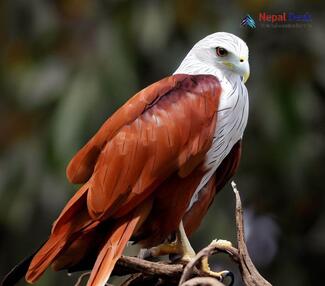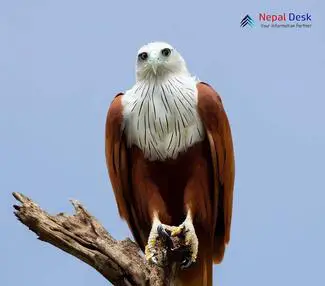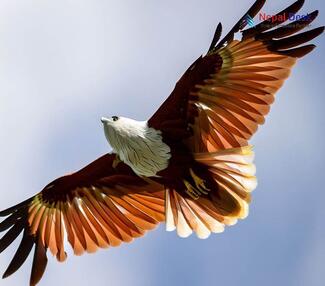With dramatic contrasting plumage of a chestnut reddish-brown body against a strikingly white head and underparts, the Brahminy Kite cuts a majestic figure gliding low over waterside habitats across Asia and Australia. As a moderately sized raptor within the genus Haliastur featuring prominently reddish coloration, the Brahminy Kite distinguishes itself through an unmistakable appearance once glimpsed. Even the bird's scientific name Haliastur Indus references India as the founding habitat for a species that thrives close to dense human settlements.
A successful opportunist able to exploit fish and meat waste near villages as well as traditional prey, the resilient Brahminy Kite adapts readily to environmental shifts that spell decline for more sensitive birds of prey. Expanding aquatic pollution now threatens new pressure though. With a wide wingspan nearing 5 feet enabling graceful flight and hovering suspensions ideal for scanning water surfaces, the Brahminy Kite performs its ecological niche with almost choreographic displays across South and Southeast Asian coastal regions. Local communities thereby enjoy proximity to a useful avian ally controlling rodent and pest populations through a natural scout ever circling the skies overhead.
Taxonomy and Physical Description
The Brahminy Kite (Haliastur indus) belongs to the Accipitridae family of birds of prey under the subfamily Milvinae grouping true kites. The genus name Haliastur originates from Greek words meaning “salt sea”, referencing occupying saline coastal habitats. Among traits classifying Brahminy Kites are a stout raptor build with broad rounded wings spanning up to 60 cm and noticeably reddish-brown plumage.
Adult Brahminy Kites showcase dramatic color contrast between a vivid chestnut brown body, inner secondary flight feathers, and tail contrasting markedly with a snowy white head, breast, and belly separated by a pale neck collar. Their short yellow beak and red facial skin circling fierce eyes match leg color. Outer wing feathers remain blackish merging into the darker rear body when at rest.
Juvenile Brahminy Kites instead hatch with more muted brown-gray heads and underparts along with lighter undersides that gradually attain definitive white-and-red adult patterning by year two for mating preparedness. When seen gliding together, the age classes present as entirely different birds to puzzling observers. Only in flight do the blackish wing feathers unify age cohorts through identification markers underscoring generations bound in aerial majesty as Brahminy Kites command intricate airborne maneuvers near seacoasts.
Distribution and Habitat
The Brahminy Kite resides prominently across two discontinuous ranges in tropical regions of South Asia and Australasia. In South Asia, Brahminy Kites breed and roost year-round in coastal habitats from Pakistan eastward through India, Sri Lanka, Bangladesh, Myanmar, and Thailand and extend into southern China and islands of Southeast Asia.
At the same time, a separate endemic Australasian population concentrates along northern and eastern Australia plus various Pacific islands after likely ancient human introduction. Fossil evidence confirms ancestral Brahminy Kites arrived prehistorically across now submerged land bridges into New Guinea and outlying Oceania as well.
Throughout its fragmented range, the Brahminy Kite favors coastline environs rich in shallow estuaries, lagoons, mangroves, and river deltas that furnish prime hunting grounds over waters supporting ample fish and crustacean populations exploitable from low aerial surveys. It also occupies agricultural zones with ample man-made irrigation reservoirs. Thereby proximity to villages proves no obstacle thanks to waste disposal practices supplementing natural prey acquisition.
The Brahminy Kite thereby mirrors density alongside human development that unintentionally aids hunting convenience along disturbed South and Southeast Asian tropical habitats. This ecological plasticity enables success despite extensive regional habitat pressures.
Feeding Behavior and Diet
The Brahminy Kite displays versatile feeding behaviors that shift between active hunting strikes to claim live prey and opportunistically scavenging already dead animals as available. This adaptability furnishes constant access to nutritional income from diverse sources.
Fish comprise over half of their wild diet captured through spectacular dives with talons outstretched to snatch just below the water's surface. Crustaceans including crabs and shrimp also face predatory pursuit during low passes over shallow marshes. Small mammals like rodents face surprise ambush when straying from cover across open ground exposed to swift descending raptors from on high.
Meanwhile, as frequent commensal foragers patrolling areas of dense human habitation, Brahminy Kites exploit discarded scraps and waste in adjacent villages, in particular seeking out rotting meat and fish remains to contain rapid nutrients. Their digestive constitutions tolerate higher pathogen levels that would sicken most birds. Thereby they provide a cleanup service recycling contaminated remnants into renewed food web energy.
In aggregate across preferred tropical habitats from Indonesia to India, the Brahminy Kite’s unique feeding ecology bridges roles as hunter, scavenger, and waste manager that showcase intricate connections binding biodiversity to rural human settlement.
Breeding and Nesting Habits
Brahminy Kites form solitary breeding pairs sticking closely within defended breeding territories. During courtship displays high over nesting grounds, the pair may clasp talons midair and whirl in the spectacle before mating occurs. Brahminy Kites typically utilize the abandoned large nest structures built earlier by crows, kites, or herons, after relining the interior with available leaves, grasses, or waste to refresh the vacant home. The female lays 1-3 unmarked eggs deposited at intervals so offspring hatch asynchronously to establish size dominance.
Across 28 days of incubation with the female conducting the majority of brooding sessions, the male furnishes constant prey items to feed his partner. Upon hatching featherless chicks in sequence, both parents increase hunting efforts taking turns nest guarding while the other seeks food fish, crabs, or rodents now needing to be delivered whole rather than consumed personally. Regurgitated bits get offered to begging chicks. As nestlings grow flight feathers around 40-50 days, parents drop food and teach aerial grabbing reflexes preparing the nearly full-sized juveniles for fledging independence vital to survival skillset mastery.
Thereafter Brahminy Kites migrate and roam extensively across seasonal conditions, returning annually to reuse nests within their carved territories announcing renewal of breeding commitments through spectacular aerial courtship pursuits with new mates or former partners, affirming seasonal bonds in the cycle of life.
Migration and Movement Patterns
Unlike many raptors that embark on extensive migratory journeys, Brahminy Kites exhibit more localized territorial ranges and seasonal dispersal movements rather than dramatic intercontinental travel across their native tropic and subtropic ranges. Mostly the kites remain largely resident year-round once reaching breeding maturity to establish nesting domains.
Some seasonal shifting does modulate conditions though. During monsoons and winters, kites may retreat from deluged inland areas towards drier coasts until rains abate. Breeding pairs also disperse when not rearing offspring as prey fluctuates, but often reside within general home range boundaries. Australian kites more nomadically chase irregular rain patterns that govern food availability far inland.
Young fledgling Brahminy Kites display the most mobile instincts dispersing widely across hundreds of kilometers until establishing suitable vacant hunting grounds to occupy into maturity. This exploratory dispersal furnishes gene flow expanding range reach that originally introduced ancestral kites deeper into Oceania's island networks. It also pioneered South Asian niche expansion thriving amidst pastoral agricultural civilization. Thereby the species continues its legacy of flourishing alongside dense human coastal inhabitations through resourceful flexibility as near urban adapters.
Ecological Role and Importance
As versatile raptors skillfully adapted to exploiting niches alongside dense human development across tropical shoreline habitats prone to rodent pest overpopulation, Brahminy Kites provide invaluable ecosystem services benefiting both natural biodiversity and cultivation through their dynamic feeding ecology.
In particular, Brahminy Kites fill a vital niche regulating prolific rodent abundance that can rapidly degrade native plant species and devastate crop yields around tropical villages. As opportunist hunters dashing low over fields to snatch exposed rats, mice, and other agricultural pests while seizing nestling chances, kites limit detrimental overgrazing from unchecked murid chapel booms. Thereby farmers benefit indirectly from encouraged Brahminy patrolling presence.
Additionally, as habitual scavengers tolerating higher toxin loads in decaying flesh, Brahminy Kites critically remove contaminant organic waste and byproducts from discarded fish and meat remains that could poison terrestrial food chains or water if left to rot haphazardly near delicate coastal mangroves. Recycling discarded nutrition supports overall ecosystem cleanliness.
Conservation Status
Classified as a species of Least Concern on the IUCN Red List, the Brahminy Kite’s flexible adaptability to human-dominated coastal landscapes has allowed relatively stable total numbers globally estimated between 100,000-1 million individuals with high-density clusters across South Asia. However, threats loom from expanding development.
In particular, the Brahminy Kites’ narrow niche reliance on fish and shrimp concentrations makes the species vulnerable as construction encroaches on crucial intact estuary and lagoon habitats. Mangrove deforestation also reduces vital roosting sites and disrupts terrestrial food chains. Additionally, aquatic pollution concentrated in commercial zones poses severe risks through bioaccumulation of heavy metals that could trigger mass die-offs from contaminated prey. Range-wide surveys remain needed to assess understudied regional populations more locally prone toward localized threats.
Conservation action includes designating protected marine buffers and enforcing fishery regulations sustaining prey sources. Outreach also promotes voluntary pools to rescue harmed raptors for rehabilitation assistance. Thereby conserving the niche Brahminy Kite spotlights sustaining the greater interwoven coastal environmental welfare across South and Southeast Asia amid development.
Cultural and Symbolic Significance
Soaring gracefully through enduring proximity with bustling tropical settlements across monsoonal southern Asia for eons, the striking Brahminy Kite has accrued rich mythological symbolism and socio-cultural resonance across Hindu, Buddhist, and Australian Aboriginal folklore traditions.
Hindu epics of the Mahabharata bestow celestial origin status upon the vivid raptor as the steed of lord Vishnu, elevating its worldly status. Buddha parables similarly analogize spiritual aspiration to the ascendant liberated flight of the Brahminy Kite unbound to earthly constraints. This theme reiterates dreamtime totems for indigenous Australian groups likewise hailing the kite as an avatar of freedom.
Ancient Egyptian hieroglyphs incorporating the Brahminy Kite connected its afternoon shadow with time. Modern subcontinental poetry celebrates tranquil kite silhouettes coasting in place high above tumultuous monsoon winds buffeting treetops unable to unsettle its masterful poise. Across artistic media, the Brahminy Kite thereby conveys symbolic ideals of divine grace and unperturbed peace through its visible public displays across the broadest skies serving creative muse for myriad cultures.
The Brahminy Kite in Nepal
Although Hindu lore features the Brahmin Kite across divine epics, real population status within landlocked Himalayan Nepal remains less studied compared to maritime Asian range nations. The absence of vast shoreline habitat likely suppresses wild numbers but Nepalese wetlands still host resident kite clusters where documented.
In particular, lowland river deltas and floodplains like Koshi Tappu wetlands and Chitwan National Park marshes provide adequate fish stocks to sustain locally dense kite groups in Nepal, even exhibiting unusual nocturnal feeding. Conservation research prioritizes assessing precisely how adapted kite occupancy may compare genetically and behaviorally to coastal cousins, given shifting prey dynamics inland.
Community monitoring also tracks threats from pesticide accumulation within food chains jeopardizing apex predators like the kites. Meanwhile, advocacy spotlights Brahminy Kites as symbolic ambassadors for protecting further wetland drainage amid development pressure from farms and dams across Nepal's fertile Terai plains. Thereby the vivid raptor features prominently as a bio-indicator species within national wildlife conservation priorities seeking balance between non-destructive progress and preserving ecosystem stability benefiting local communities and charismatic wildlife alike through shared waterway stewardship.
Challenges and Future Prospects
While adaptable to human activity, expanding coastal development poses an urgent threat to sustained Brahminy Kite niche stability through the destruction of intact inshore habitats like tidal flats and mangroves that furnish shelter and food chain foundations. Reclamation projects in particular endanger remaining shallow estuary zones. Also looming is the specter of widespread chemical pollution permeating aquatic systems to poison kite prey turnover.
Climate shifts degrading monsoonal patterns may stress reproduction success and impact winter feeding periods. With habitat loss constraining home ranges, conflict likelihood with fishery enterprises heightens without mediation. Thereby integrated land management is essential for sustaining Brahminy footholds respecting the intrinsic habitat needs underpinning this critical scavenging raptor’s resourceful existence across the improvised ecological opportunities crystallizing around old village symbiosis.
Fortunately, Brahminy Kites elicit public fascination across settled tropical Asia. Leveraging cultural regard for the species through prominent awareness campaigns can build constituencies defending critical protections around remaining intact habitats and kite food resources. By granting NGOs some wetland steward authority, targeted policies also strive to balance development pressures with conservation that rewards rather than punishes continued traditional harmonious kite-human interface benefiting all parties.
Conclusion
From shoreline mangroves of Mumbai shadowed by sky-scraping towers to estuary channels meandering through tiny Balinese fishing villages, the vividly patterned Brahminy Kite flourishes as an ecologically invaluable fixture of developed tropical habitats across Southern Hemisphere continents. Its scavenging niche maintains balanced food chains, and its aerial patrols organically check rodent infestations threatening fragile island ecosystems and grain agriculture vital to communities. Thereby the Brahminy Kite bridges environmental welfare to cultural heritage through the very conspicuous visibility mounting untiring circular marches over sustaining tropical settlements.
Yet the symbiotic ecological services this enduring raptor contributes across village environs now risk undermining as habitat loss and unmitigated pollution escalate with compounding climate instability disrupting fragile regional conditions. Intact mangrove stands and undeveloped estuary zones require urgent guarding to furnish adequate niche viability against ill-fated overdevelopment degrading this long-served commensal species. By spotlighting Brahminy Kite dependence as a focal indicator for wider environmental health, conservation policy, and public commitment can still reciprocate needed protections sustaining populations across treasured tropical habitat strongholds from Australia to the subcontinent as our shared natural heritage in a warming world.




